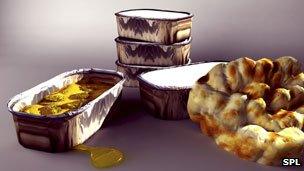Takeaway dishes high in colourings, says study
- Published

The meals can contain high levels of salt, fat and artificial colourings, the study suggests
Two of the nation's favourite Indian and Chinese takeaway dishes can contain illegally high levels of certain colourings, a snapshot study suggests.
High levels of salt and saturated fat were also detected in chicken tikka masala and sweet and sour chicken meals at 223 takeaways in England and Wales.
And the Local Government Group study, external says that when nut-free chicken tikkas were ordered, 20% still contained nuts.
The Department of Health said labelling was key.
The analysis of 90 Indian takeaways was based on a portion of chicken tikka masala and pilau rice.
The Food Standards Agency has called for a voluntary ban on artificial colourings including sunset yellow (E110), allura red (E129), tartrazine (E102) and ponceau 4R (E124) because of their reported link to hyperactivity in some children.
When the sauces from 25 of the meals were tested for the colourings, five of the dishes were found to contain levels above the permitted maximum of 500mg/kg allowed under current food regulations.
The study also found that the Indian meals contained 116% of an individual's daily recommended saturated fat intake and 92% of their salt intake.
A similar analysis of sweet and sour chicken and fried rice from 133 Chinese takeaways discovered that the dish contained 119% of the recommended daily salt intake and 16 teaspoons of sugar, 75% of the recommended daily limit.
Eating too much salt is linked to high blood pressure, which can also increase the risk of developing heart disease.
Recommended dietary salt levels vary with age. Adults are recommended to have no more than 6g of salt per day in their diet, while toddlers should have no more than 2g.
Analysis of 11 sauces of the sweet and sour chicken meals found one contained illegally high levels of the colourings.
Nut danger
When buying some of the chicken tikka masala meals, it was stressed that the customer had a nut allergy.
Despite this, one in five of these takeaways contained peanuts or almonds without any warnings being provided. Just a small amount of nuts can be fatal for someone with a severe allergy.
The Local Government Association said local authorities should work with "ethnic kitchens" to make sure false information was not provided when customers requested a meal which does not contain nuts.
On two occasions the meat found in sweet and sour chicken meals was actually turkey.
Pre-packaged meals sold in shops are required to carry details of artificial colourings.
A spokesman from the Department of Health said there are plans to give takeaway outlets guidelines on how to label their products.
"The government's Responsibility Deal includes actions that can be taken by restaurants and takeaways, for example by providing calorie information for food and drink.
"Whilst this work has to date focused on larger, chain restaurants, guidance for smaller businesses will be produced in due course. This will help maximise the opportunities for people to see, and use, calorie labelling."
Councillor Paul Bettison, chairman of the Local Government Regulation Board which carried out the study of takeaway meals, said that the high levels of fat, salt and sugar in them were "truly shocking and unnecessary".
"There's no excuse for illegal amounts of colouring and as for secretly using a cheaper type of meat, that's just shamefully ripping off customers. And including nuts when you've been told a person suffers from a nut allergy is unforgivable, it could potentially kill them.
"There are many ways to make takeaways more healthy such as using lower fat oils, natural colourings and reducing salt. These needn't compromise taste and promoting such a healthy approach often attracts customers who're keen to watch their waistline or their blood pressure."
- Published10 October 2010